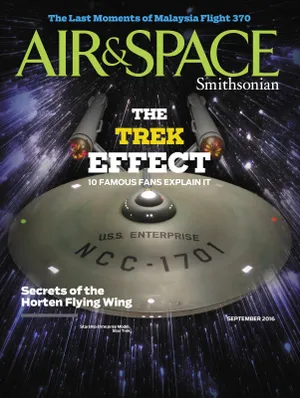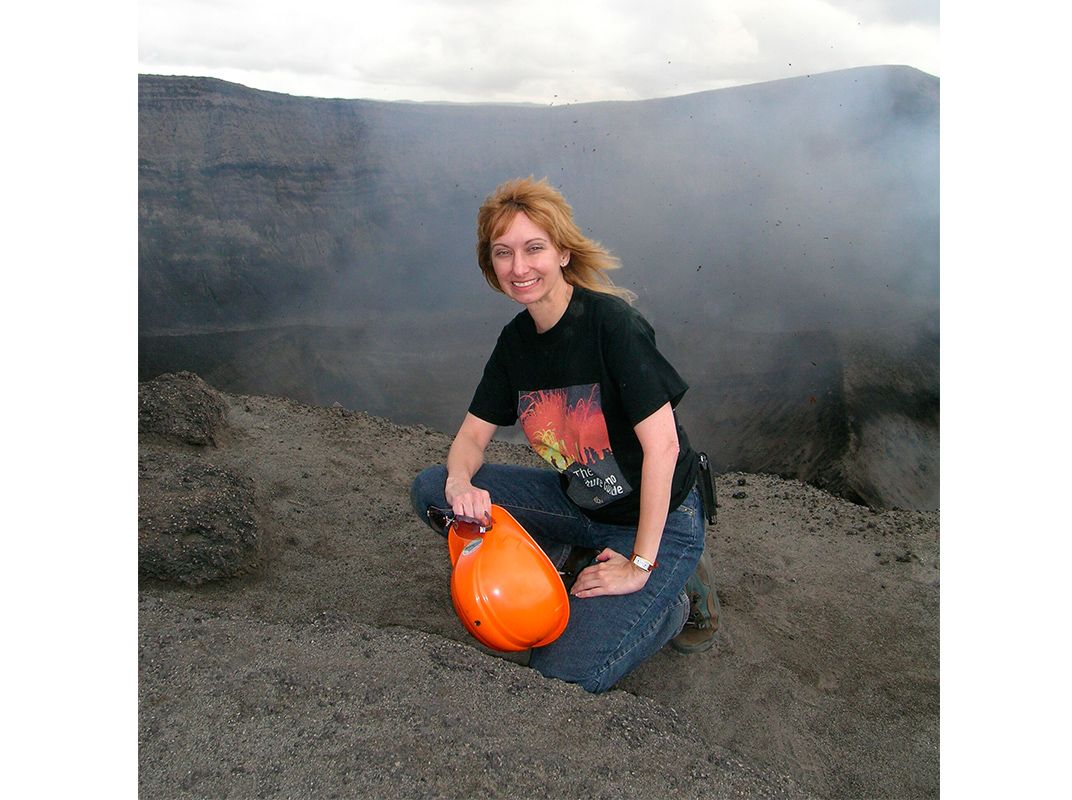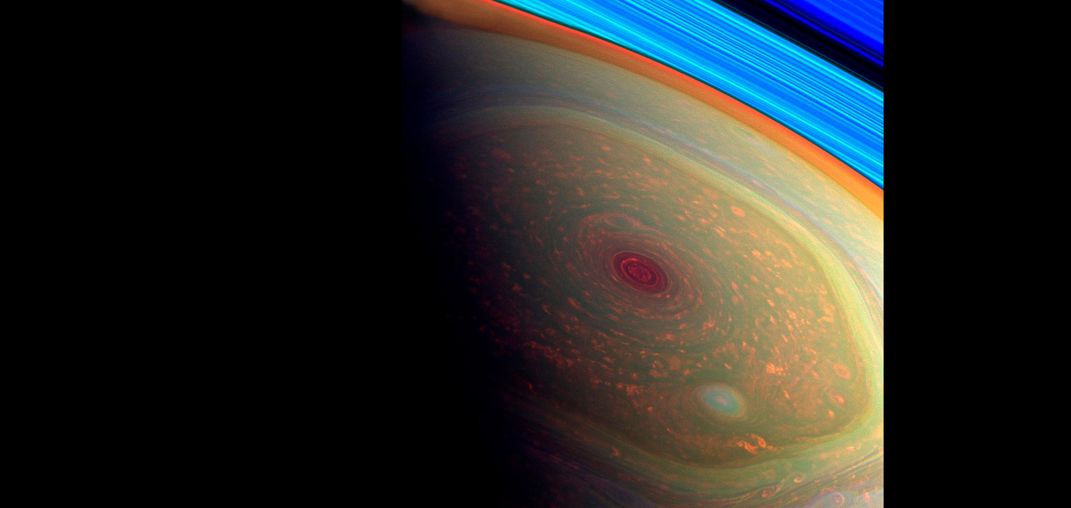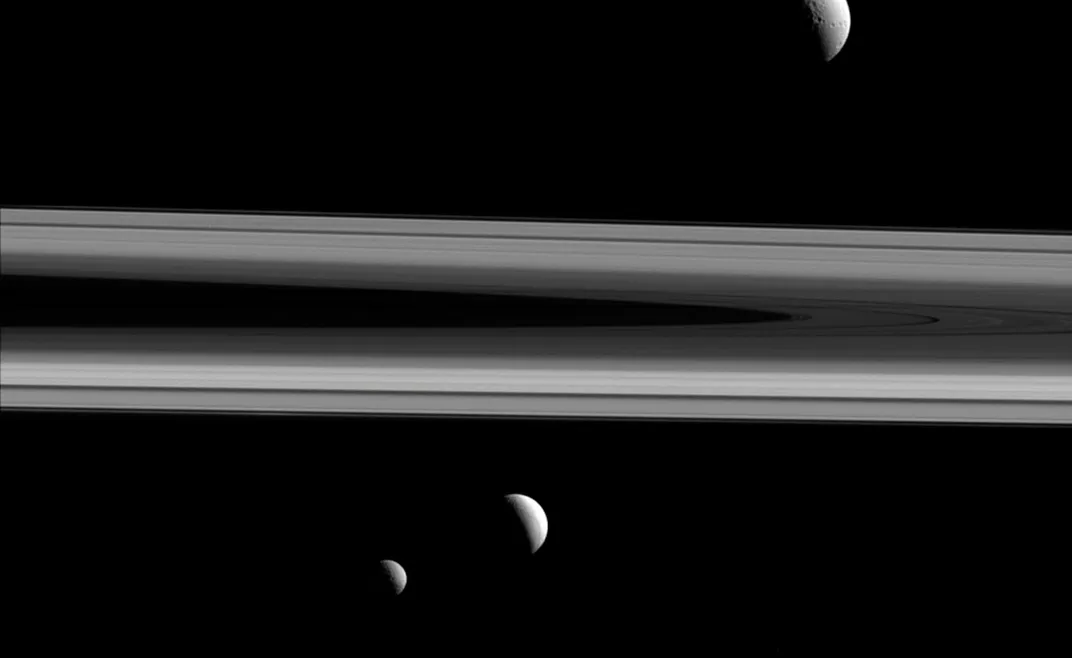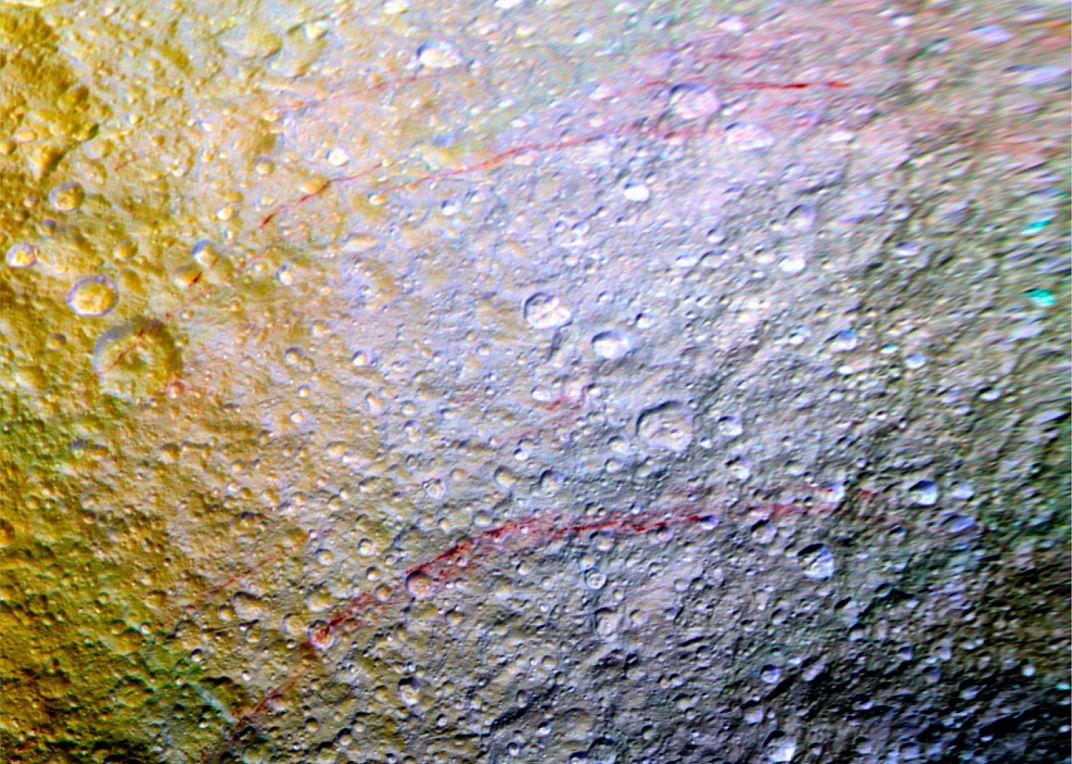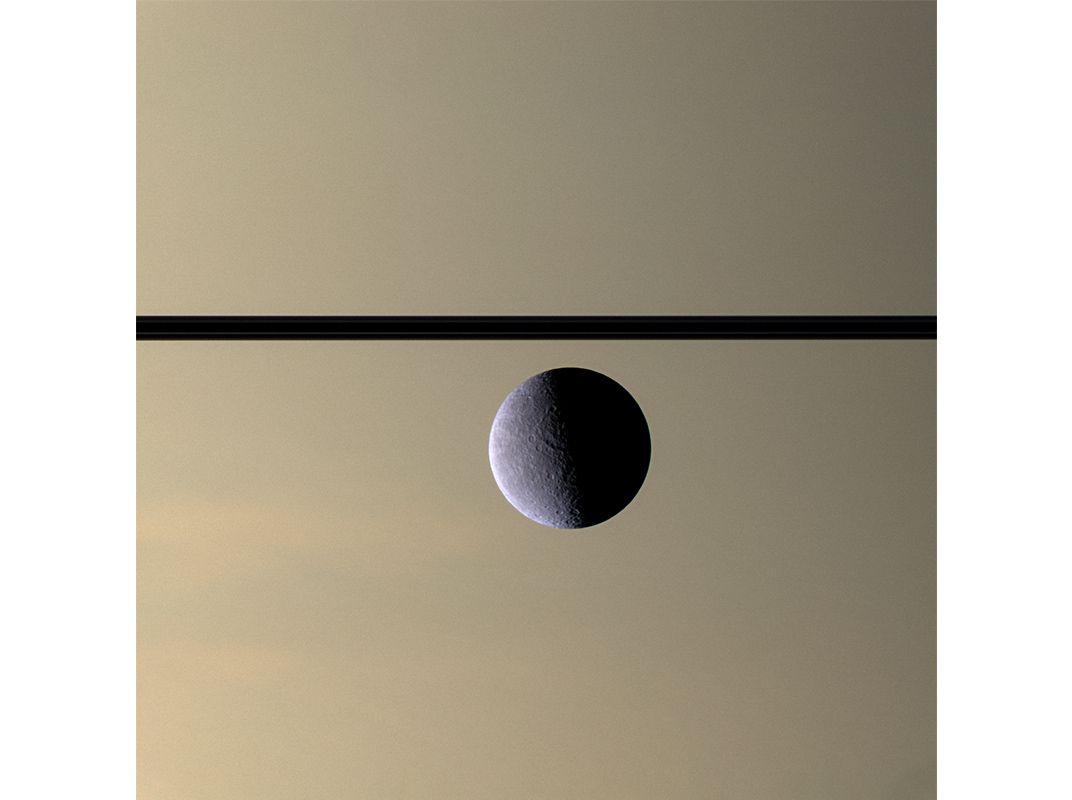Last Days at Saturn
For 20 years, Cassini has been exploring the ringed planet. Now it’s time for the team to say goodbye.
:focal(5450x2050:5451x2051)/https://tf-cmsv2-smithsonianmag-media.s3.amazonaws.com/filer/8b/77/8b7785af-c143-4125-975e-2f2ffd558ef3/05e_sep2016_saturnpia06193_live.jpg)
Cassini, a robotic spacecraft the size of a small school bus, was orbiting Saturn on December 5, 2010, just as it had been every day for more than six years, when one of its dozen instruments went berserk. Called RPWS, for Radio and Plasma Wave Science, the instrument monitors radio signals emanating from the giant gas planet, clues to the changing condition of its magnetic fields, as well as lightning in its turbulent atmosphere. On one pass, everything was normal. On the next pass the signals “had totally changed,” recalls Andy Ingersoll, an atmospheric scientist at the California Institute of Technology in Pasadena.
Along with scientists at the nearby Jet Propulsion Laboratory and others around the world, Ingersoll quickly realized that the anomaly was caused by a storm—a monster storm. The weather on Saturn, like so much about the planet, is bizarre, with lightning 10,000 times more powerful than anything on Earth and winds that have been clocked at up to 1,100 mph. What’s more, a single storm can wrap around the entire planet.
The strangest thing about this particular outburst was the timing. Storms tend to occur every Saturn year (30 Earth years), during northern summer, but this one wasn’t due for another 10 years. “If it had kept to its 30-year cycle, we would not have been there” and would have missed out on all this science, says Scott Edgington, Cassini’s deputy project scientist. The early appearance of the Great Springtime Storm, as the scientists came to call it, enabled them to track its progress over time, something they’d never done from such close range.
This wasn’t the first—or last—time that Cassini, NASA’s most ambitious planetary mission to date, found something entirely new. In January 2005 the cameras caught plumes of water ice spraying from Saturn’s ice-capped moon Enceladus, instantly adding that world to a short list of possible abodes for extraterrestrial life. That same month the companion Huygens probe had touched down on the gloomy surface of Saturn’s largest moon, Titan—one of the all-time great feats of space engineering, and the only landing to date in the outer solar system.
It’s been eight years since Cassini’s tour of Saturn was supposed to have ended, 19 years since it left Earth, and more than two decades since most of its electronics were assembled (so long ago that smartphones and MP3 players didn’t exist, and the Internet was a novelty). The mission has been extended twice, and still the data flows in from Saturn.
And for all that, Cassini has been remarkably problem-free. Radar team scientist Rosaly Lopes—one of more than 5,000 people who have worked on the project over the years—has enjoyed the easy pace. Lopes previously worked on the Galileo mission to Jupiter, which suffered a series of hardware problems, most notably the failure of a key antenna to open, that forced a lot of workarounds and compromises and limited the data that was collected. “I was tired of drama,” she says, with a deep, knowing sigh.
With Cassini, it’s been the opposite: Some things have turned out better than expected. The spacecraft’s solid-state recorders, for instance, “should be shot through with holes [damaged storage cells] by now from radiation,” says Earl Maize, Cassini’s program manager at JPL, yet they’re practically as good as new. The Huygens probe continued to transmit data from the surface of Titan longer than anyone predicted. When I suggest that Cassini might best be named the Serendipitous Mission, Maize balks. “We tend to call it planning,” he says.
The project began, as many space missions do, with a simple idea: Send a spacecraft to orbit Saturn—not just to zoom past quickly, but to stick around the neighborhood and explore the planet and its moons thoroughly. The year was 1982. Ronald Reagan was in the White House, the space shuttle was new, and the summer before, Voyager 2 had rushed by the planet, its rings, and moons, returning hundreds of close-ups of Saturn.
The Voyager images and data were spectacular, and they increased the scientists’ appetite. The Galileo mission to orbit Jupiter was already in the works. Why not do the same thing for Saturn? From the beginning, it was agreed that the mission should be international—the “most intimate and intricate” such collaboration to date, according to Jonathan Lunine of Cornell University, an interdisciplinary scientist working on the mission. Some 19 nations joined the project, along with the European and Italian space agencies.
The decision to go global wasn’t just to accrue “feel-good points,” as one Cassini scientist puts it. There were tangible benefits to the partnership. For instance, one of the mission’s most novel ideas—to use Titan’s gravity to shape the spacecraft’s repeated orbits, thus saving precious maneuvering fuel—came from a French engineer. And Europe picked up about 20 percent of the mission’s $3.3 billion cost, including designing and building the Huygens probe that, after separating from the Cassini spacecraft shortly before arrival at Saturn, landed on Titan in January 2005.
There were cultural differences to overcome, but these were blunted by the fact that everyone spoke fluent science. Says one Cassini team member, “It’s not French or German or American scientists working on the mission. It’s Earthlings.”
Named after Giovanni Cassini, a 17th century Italian astronomer, the mission is like an orchestra, and Maize, the program manager, is its conductor—“but with first chairs around the world.”
One of those first chairs is Andy Ingersoll, a Caltech planetary scientist who jokingly describes himself as “the old man in the group.” Judging from his frenetic schedule and the hiking gear stashed in one corner of his office (at the time of my visit he was about to tackle Mount Whitney in the Sierra Nevada, the highest peak in the contiguous United States) his age—75—has not slowed him down.
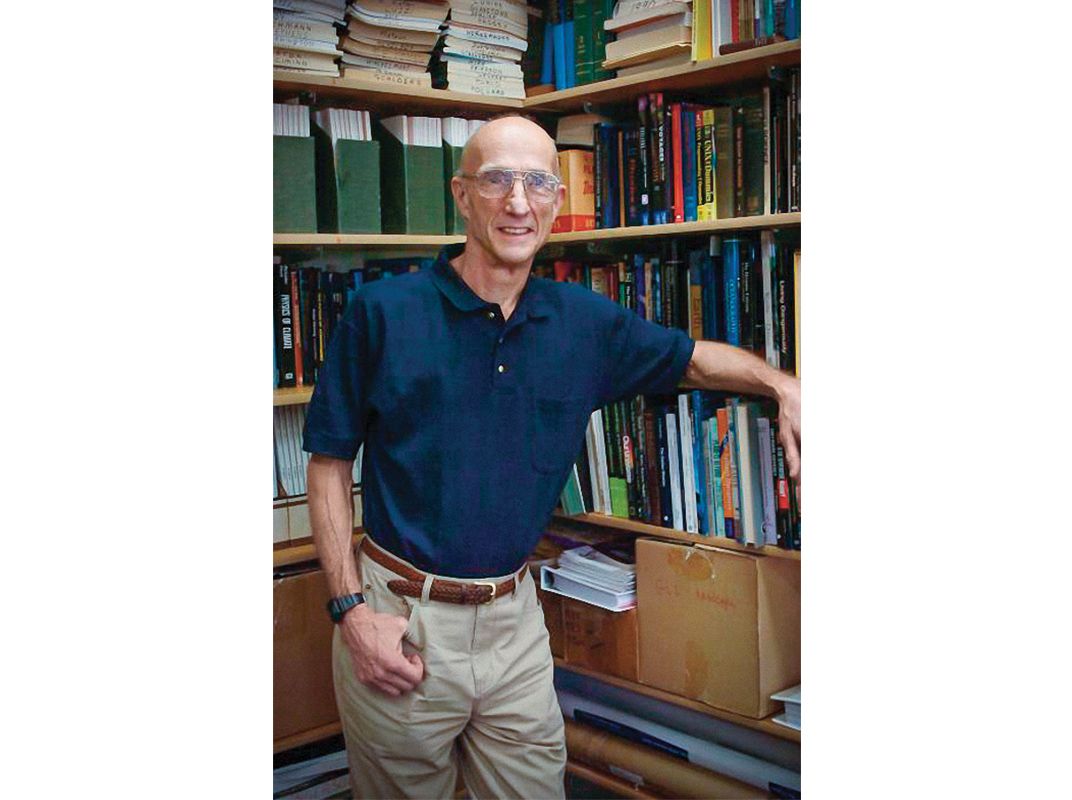
Sipping his coffee, Ingersoll remembers the modest beginning of outer solar system exploration in the late 1960s when, as a young planetary scientist fresh out of grad school, he was placed in charge of the infrared radiometer for Pioneer 11—the first probe to visit Saturn. Ingersoll’s instrument had two settings: on and off.
“Sounds like something in my kitchen,” I say.
“What’s in your kitchen is much more sophisticated.”
Not only have the instruments improved, the people have changed. Margaret Kivelson, a UCLA scientist who specializes in planetary magnetic fields, recalls that during Galileo planning meetings in the 1970s, “I was one of two women in the room.” Many Cassini team members are women, including the project scientist and the spacecraft operations team manager. “It’s a huge leap,” she says.
**********
Spend enough time at JPL’s sprawling campus and soon you notice the ubiquitous Cassini Mug. No ordinary coffee cup, it’s covered with illustrations of all 12 instruments on the spacecraft; in order to see them all, you need to rotate the mug. That’s a metaphor for one of the knottiest technical difficulties of the Saturn mission. Cassini has no independent, movable scan platform like the one on the Voyagers, which allowed multiple instruments to point at the same target simultaneously. On Cassini, the instruments are attached at different locations around the body of the spacecraft, so they have to take turns moving into viewing position. With a scan platform, a spacecraft pivots like a young gymnast. Without one (“body fixed” in NASA parlance), it’s more like a middle-aged man in a neck brace. Each observation takes a long time, and must be planned well in advance.
Thus, Cassini scientists were forced to jostle for that scarcest of commodities: observing time. As the spacecraft approached, say, the cloud-covered moon Titan, each of the dozen instrument teams made its case for why it should get to “go prime,” or have the best view when the spacecraft is closest to a particular target.
These negotiations were “very tense, and very intense,” says Cassini team member Christophe Sotin. “You come armed with your science. You don’t say ‘I want that because I want that.’ You’re not a kid.” The negotiations sometimes get heated, agrees Rosaly Lopes, whose specialty is the geology of Titan.
Long missions like Cassini mirror the arc of a scientist’s career. Each stage is distinctive, and the spacecraft—indeed the mission itself—matures. It took seven long years of traveling, at an average of more than 54,000 mph, to reach Saturn. During that time, people married. Children were born. (Some on the Cassini project say they planned their pregnancies around mission events.) Like the scientists, the spacecraft has aged: A flywheel that controls pointing is “cranky,” a spectrometer for studying electrically charged plasmas in the planet’s environment has died. “Basically, it shorted out,” explains Linda Spilker, Cassini’s project scientist, as if describing a toaster oven.
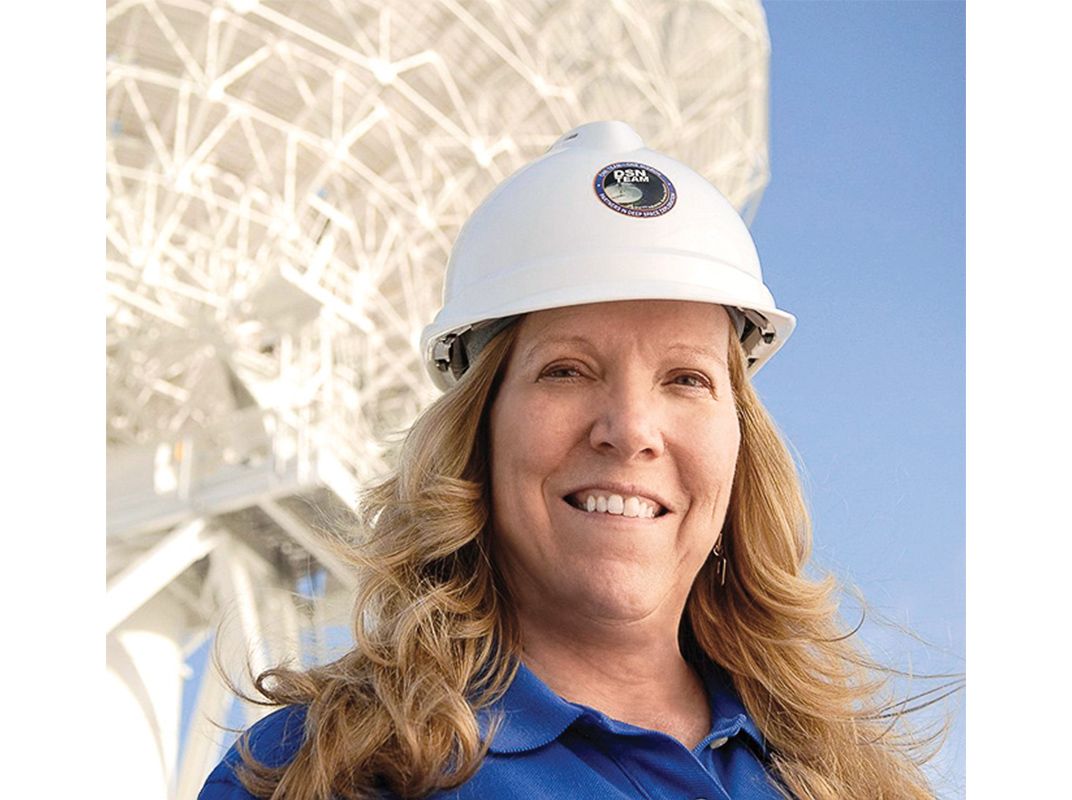
What’s really evolved, though, are the questions. Every discovery leads to new ones. Cassini has, for example, enlarged our notion of our solar system’s “habitable zone”—the swath of space where conditions are ripe for possible life. Says Andy Ingersoll, no longer do we think of it as a relatively narrow band from Venus to Mars, where liquid water can exist on a planet’s surface without freezing or boiling off. Rather, we now consider the whole solar system as potentially habitable, partly due to Cassini’s discovery of an ocean under the ice cap of Enceladus.
Before Cassini, planetary scientists knew almost nothing about Titan. By using its onboard radar to pierce the orange haze, Cassini has mapped a substantial part of the surface and “turned Titan from a veiled moon to a world,” says astrogeologist Karl Mitchell, wearing the standard JPL attire of T-shirt and jeans. That’s the word he prefers—a world, not a moon, since “moon implies ‘dead’ to most people,” he says, and Titan is far from dead, at least geologically speaking. It has clouds and rain. It has rivers and lakes and oceans—and is very much in the habitable zone. We know all this because of Cassini.
Mitchell recalls standing in the operations control center and staring at one of the first images from Titan as it dawned on everyone in the room what they were seeing. “We were looking at the first alien lake. It was amazing,” he says, transported back to that moment. It was a rare group experience. Space missions—like our lives—are more atomized, and these days scientists tend to witness such events separately, as the data streams across monitors in their offices.
The discovery of the Enceladus water plumes was slower, subtler—more of a dawning realization than a single shocking moment. Few expected the icy moon to be anything other than a lump of inactive material. The first sign that the scientists were on to something unusual was in images taken in January of 2005, showing what appeared to be a faint spray emanating from the moon’s south pole. A month later Cassini’s magnetometer detected “a bump, a draping almost, of the magnetic field of Saturn over Enceladus,” says Cassini scientist Bonnie Buratti. They later learned that the bump was caused by a giant plume, a geyser consisting of ice and water particles. “It was this blazing glory, this boiling cauldron at the southern pole of Enceladus,” says Buratti. Later images caught the geysers in the act of erupting. Again, Cassini was in the right place at the right time. “Even now, I look at those [images] and think, ‘How lucky we were to find this!’ ” says Carolyn Porco, head of the mission’s imaging team.
Discovery of the global ocean underneath Enceladus’ icy surface was less clear-cut, the result of circumstantial evidence and rigorous detective work. The moon’s libration—wobbling in its orbit—became apparent after scientists carefully examined images of the moon that had been taken over seven years. The sloshy water deep within Enceladus affected the moon’s orbit, in the way a raw egg spins differently from a hard-boiled one.
In the years Cassini has been orbiting Saturn, scientists also have learned a lot about the planet’s famous rings. They originally thought the rings consisted of individual particles colliding more or less randomly with one another. The reality turns out to be more complex and interesting. The rings are constantly clumping together and forming new structures.
“The structures almost line up like rows in a marching band,” explains Linda Spilker, with a glint in her eyes. “You have these long ropey structures that are ephemeral. The particles clump together, then the big kid on the block comes through, breaks the particles apart and they come back together again.”
Some of Cassini’s revelations have come from the stunning digital images the spacecraft has taken of Saturn and its moons, including one rare photo where Earth—that “pale blue dot,” as Carl Sagan put it—is visible in the distance. Many of the mission’s biggest findings, though, have come from less sexy instruments with clunky names like the Visual and Infrared Mapping Spectrometer, which was capable of seeing through haze and revealing the surface of Titan for the first time.
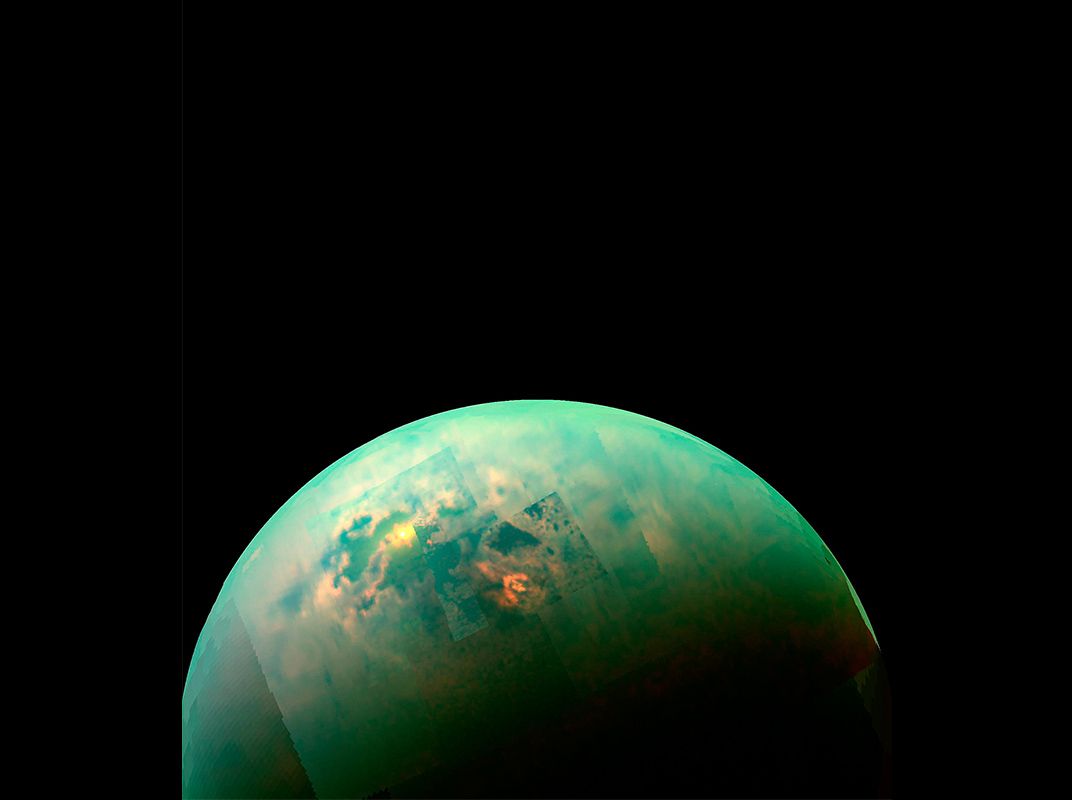
**********
On Cassini, as on every space mission, there are two distinct, but complementary, teams: the engineers, whose job is to keep the spacecraft flying, and the scientists, who are driven to gather information. They don’t see the world through the same lens. Engineers tend to be risk-averse. Scientists are greedy; they always want more—more missions, more flybys, more data. “We wanted it all and when they gave it to us, we wanted more,” says Lunine. He likens the engineers to Scotty from Star Trek. “We say ‘We want to do this’ and the engineers say ‘You can’t do that; it’s not possible.’ And then they do it anyway.”
A sort of game takes place between scientist and engineer, one that each plays with a wink and a nod. If the scientists want something, such as an extra-close flyby of one of Saturn’s moons, they’ll “put an engineering gloss on it,” explains Buratti. They might suggest they just want to “test the instruments,” when in fact they’re hungry for fresh data, as they always are.
Julie Webster, who manages the spacecraft operations team, is one of those risk-averse engineers. She remembers how nervous she was on the day back in 2004 when the spacecraft finally arrived at Saturn. And for good reason. She had been part of the Mars Observer mission that went silent three days before it was expected to enter orbit around the Red Planet in August 1993. The engineers never heard from it again. (The failure turned out to be due to a problem with the propulsion system.) Nothing went wrong for Cassini’s orbit insertion, as the 12-year-old photo of Webster with arms raised, pumping the air, reveals. She recalls clearly the moment when the spacecraft emerged from the planet’s shadow, on time and in the right orbit. “It was a great day,” she says. “There are days that are crystallized in your memory.”
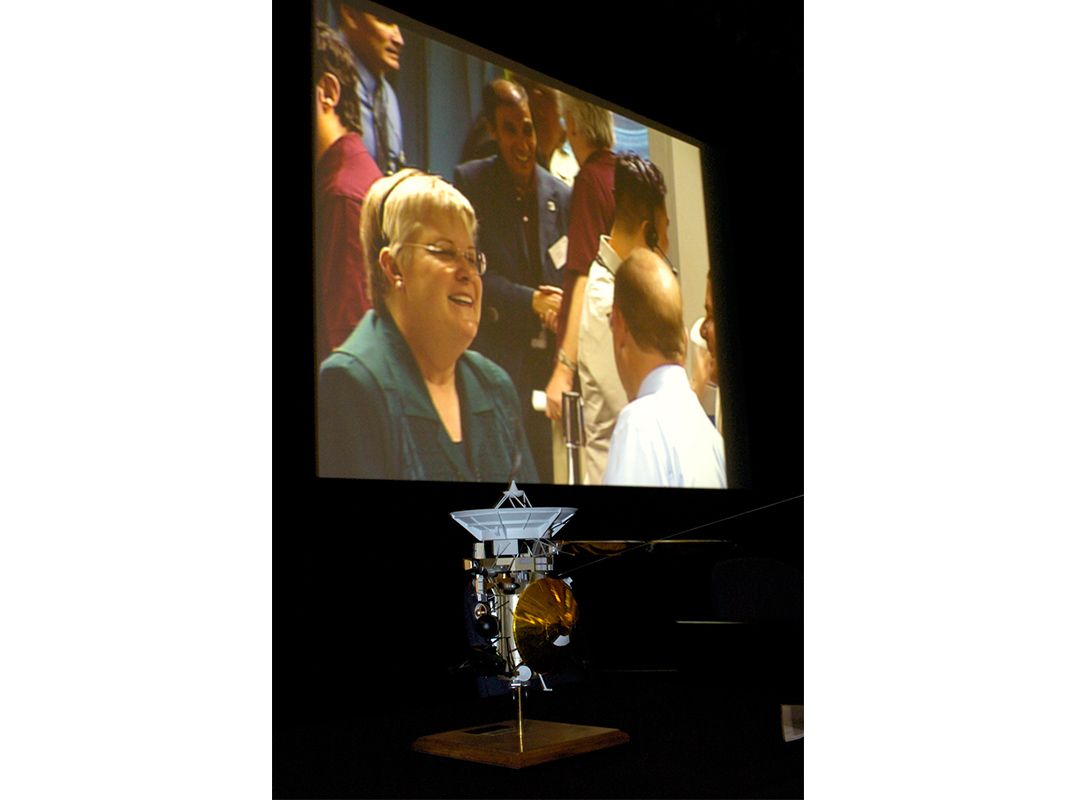
Webster speaks of the spacecraft with a fondness usually reserved for children and pets. Her office is cluttered with Cassini memorabilia, including a graph depicting the trajectory it took during SOI, or Saturn Orbit Insertion.
She’s been with the project from day one. She was in the clean room, the stark white facility free of dust and other contaminants, a short walk from her office, when Cassini was being assembled. She placed her hand on it, communed with it in a way, and now, when she looks up at the night sky, she feels close to the spacecraft, even though it’s some 750 million miles away.
It’s moments like these that have kept her at JPL all these years. Before coming here, she had floundered, working, among other things, as a chemist, hopping from one job to another. “I found my calling,” says Webster, who is the closest thing Cassini has to a pilot.
Nothing happens on the spacecraft that she doesn’t know about. She talks to it, and it talks back. “It tells me everything. It tells me its temperatures. It tells me how much power it is using. It tells me how the flight software is doing. It tells me all the science data and when the packets were downloaded.” (These conversations don’t happen in real time, however—it takes 90 minutes for radio signals to travel from Cassini to JPL.) Webster says Cassini is more Lincoln Town Car than Ferrari, but that stability and reliance have earned her respect and—there is no other word for it—affection. “Even if my career would last another 20, 30 years,” she says, “there’s just never going to be another one like this.”
**********
Still, the mission has not been flawless. The biggest scare came en route to Saturn, when engineers found a problem in the communications software that could have jeopardized the data returned by the Huygens probe as it parachuted down to Titan. (The probe is named after Christiaan Huygens, the 17th century Dutch astronomer who discovered the moon.) The team had failed to properly account for the Doppler effect on Huygens’ radio signals as the probe decelerated in the Titan atmosphere while communicating with the main Cassini spacecraft. For a while, it seemed possible that scientists wouldn’t get any data from Huygens during the descent. “We were all really terrified about that,” recalls Cornell’s Lunine. In the end, the problem was solved by engineers—“some very creative people,” says Lunine—who minimized the Doppler shift by revising the main spacecraft’s trajectory, reducing its velocity relative to the probe. Huygens landed safely, and successfully relayed the full load of data. It was, notes Porco, “a Jules Verne adventure come true.”
No adventure lasts forever, though, and the spacecraft is “well beyond its warranty period,” says Lunine. More critically, it’s running out of gas. The empty light has been on for some time, in fact. “And we don’t have a five-gallon jerry can in the back,” jokes Webster. Without propellant for its main engine, the spacecraft can’t make the precise orbit adjustments it needs to continue exploring the planet and its moons.
But how to end the mission? NASA considered several options. Could it use Titan’s gravity to slingshot Cassini out of Saturn orbit and dispatch it on to Neptune or Uranus? Or perhaps leave it in orbit around Saturn indefinitely? In the end, NASA chose a third, more radical, option.
“Kill it,” says Andy Ingersoll. “They’re going to kill it.” More precisely, they’re going to steer the spacecraft into the planet’s stormy atmosphere. Starting November 30, the spacecraft will be maneuvered into a new orbit that takes it high over the planet’s north pole, then just outside the main rings, for 20 orbits in all. Then, on April 22, 2017, things will get a little more daring, as the spacecraft begins an even closer series of 22 orbits, each taking six days, that brings it between the planet and the main rings. On the last orbit, on September 15, 2017, it will finally succumb to the planet’s gravitational pull, drop into the swirling atmosphere, and disappear. The team, after taking suggestions for names from the public, has dubbed the maneuver the Grand Finale.
It might seem like a cruel way to treat a spacecraft that has performed so admirably, but NASA officials say it makes the most sense. The trip from Saturn to Neptune would have taken 40 years. And if Cassini were left in an endless, rudderless, orbit around Saturn, it could one day collide with a moon like Titan or Enceladus, which could disturb any life that might exist there. It’s called “planetary protection,” a guiding principle of space exploration akin to the “prime directive” of Star Trek fame: Don’t interfere with indigenous life forms.
Cassini’s managers intend to make the most of its last days. Says astrogeologist Karl Mitchell, the Grand Finale gives the team “a chance to reap one last glorious rush of science.”
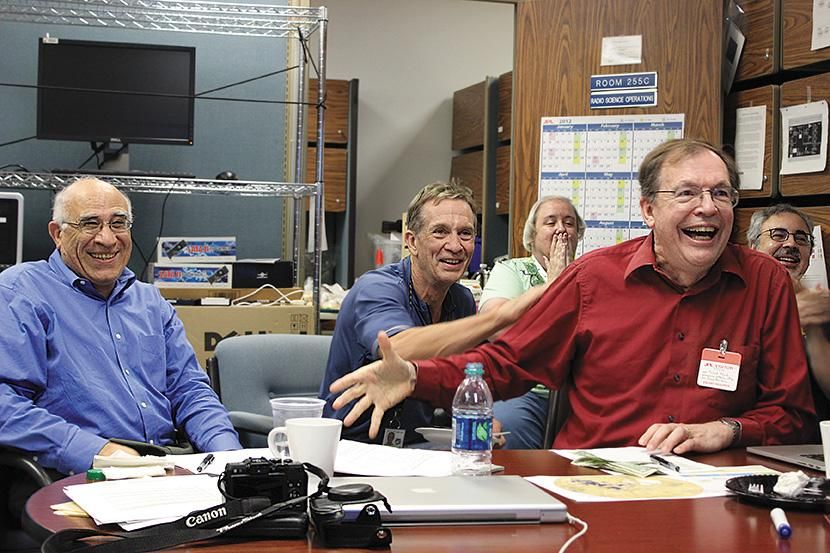
Using Titan’s gravity for free propulsion, engineers will steer the spacecraft to pass closer than any man-made device has ever come to Saturn–“crazy close,” says one scientist—just 2,400 miles from Saturn’s cloud tops. Its cameras will be able to capture images with much higher resolution than those taken before, and higher resolution usually means better science. From such close range, Cassini also will be able to take precise measurements of Saturn’s gravity field, which will improve estimates of its mass.
The Grand Finale has been years in the planning, and the engineers and scientists talk about it with mounting enthusiasm, calling it “a whole new mission.” Scott Edgington puts it in more kinetic terms: “I’m imagining one of those roller coasters at Magic Mountain where you’re going over the edge 22 times, just diving down, hands up in the air and just cherishing the data you’ll get back.”
Andy Ingersoll knows exactly where he’ll be on the evening of September 15, 2017: in his backyard, sipping a beer, listening to a band, and enjoying the company of his fellow Cassini scientists and engineers. He will celebrate “the fact that we haven’t come to blows, and we’ve successfully enjoyed the scientific spoils.”
Others are more forlorn about the spacecraft’s last hurrah. “It’s kind of like a death,” says Buratti, dropping her scientist face. “Spacecraft lives do end, just like people’s lives end.”
Julie Webster, attached as she is to the Saturn orbiter, will shed no tears on September 15. “It’s 40 years old and it’s time,” she says, smiling at the thought of Cassini dying the way it lived. “If you have to go, and everybody does, go out with a bang.”
In a way, Cassini is not really dying. The data it has collected over the years will live on. “There are going to be generations of Ph.D.’s looking at this data and making discoveries,” says Edgington. It’s happened before. Scientists discovered a moon of Saturn, called Pan, in Voyager 2 images—nine years after the spacecraft flew past it.
Sometimes space exploration is a sprint, as it was during the cold war, and sometimes it’s a marathon. But it’s always a relay race. As one mission ends, the baton is passed to the next. Pioneer led to Voyager, which led to Galileo and Cassini. And while NASA has no specific plans to return to Saturn after 2017, there are plenty of ideas for Enceladus missions and Titan landers. That’s one thing you can count on: Scientists will always have another idea for exploring the solar system.
